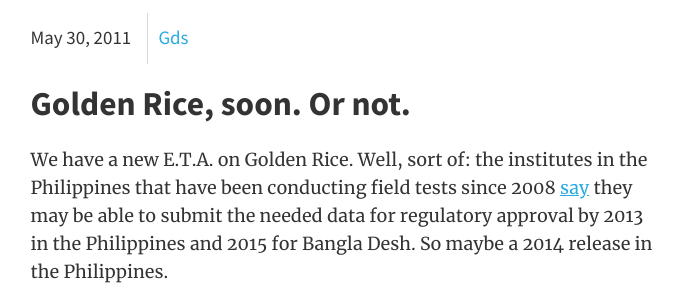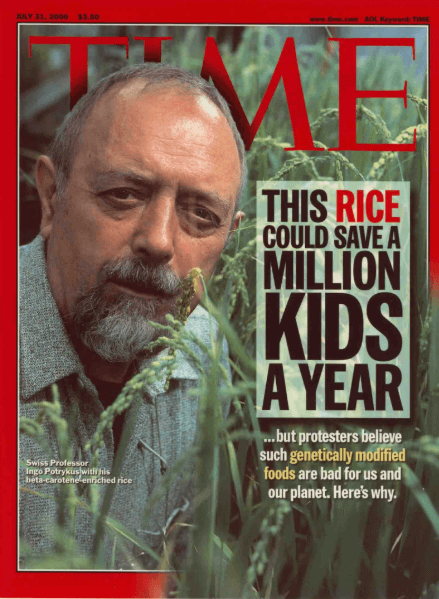The good news is that the government of
Bangladesh is about to approve Golden Rice for commercial release some time in the next three months.
First and foremost this is fantastic news for Southeast Asia for
humanitarian and economic development reasons. On a less consequential
level this is great news for the overall debate surrounding the use of
biotech in agriculture. Golden Rice occupied a space in the debate as
the
Great Golden Hope of Biotech Crops, a wholly virtuous crop
devoid of the grubby commercial concerns of intellectual property or
profit motive. In this case, the IP had been donated, the rice was being
developed by a non-profit NGO and the rice will be given freely to
farmers and local breeding programs—a trait of value directly to
consumers, among them some of the most vulnerable people on the planet.
Because of this history, it is a crop not linked to so-called
‘industrial agriculture’ and its key trait is not tied to pesticide use.
Golden Rice has long been promoted as an application of biotech that
is seemingly beyond reproach, although that didn’t stop critics from
coming up with cynical and loopy objections: e.g. Golden Rice is a
stalking horse for corporate control of agriculture in Southeast Asia;
it is a distraction from solving the problems of poverty and equitable
food distribution, etc, etc. But the halo that surrounded Golden Rice
had faded considerably in recent years, as its release date, which has
been ‘just around the corner’ for the last decade and a half kept
getting pushed back into what seemed like a permanently receding future.
For the entire time that I’ve been paying close attention to the GMO
debate, beginning around 2011, Golden Rice has been both just around the
corner and long overdue, which has made it an easy target for
environmental NGO critics. Advocates often had an unfortunate way of
referring to Golden Rice in a weirdly liminal space between a pipeline
crop with theoretical benefits that would probably bear out and a
already existing commercially released crop already in production. There
has also been an unfortunate tendency to over-estimate how much the
destruction of crop trials set back the time-line and impute them with
genocidal consequences. One
2014 paper calculated “1.4
million life years lost over the past decade in India” but was
predicated on the idea that Golden Rice had been available since 2000
and was entirely held back by critics of genetic engineering, in the
form of overly precautionary regulations of field trials. This became a
trope that circulated widely in pro-GMO circles and formed the
foundation for many a hysterical charge of genocide against GMO critics,
even those who questioned the wisdom of herbicide tolerant crops who’d
registered no objection to Golden Rice. But it is not the case that
Golden Rice has been available since 2000 or that regulation rather than
formidable technical challenges have been the main bottleneck.
 This
anti-biotech blog post from 2011 highlights the way appeals to the
potential of Golden Rice became less and less persuasive as the release
date seemed to perpetually recede into the future.
This
anti-biotech blog post from 2011 highlights the way appeals to the
potential of Golden Rice became less and less persuasive as the release
date seemed to perpetually recede into the future.
The most straightforward criticism from opponents became increasingly
difficult to parry over time, “If genetic engineering is so great, why
is Golden Rice taking forever to get right?” The appropriate response to
that question illustrates the quandary faced by biotech advocates, for
it is both reasonable and factually correct, but to the ears of an
opponent of biotech in agriculture, unpersuasive.
First, the International Rice Research Institute (IRRI) should be
applauded for setting a high bar in terms of the amount of beta-carotene
and yield required for them to seek commercial release. They apparently
have never felt pressure to release a product not up to the task at
hand simply to “get something out there”. Most outrageously, its rich
for critics to blame shortcomings of the technology for the delay when
the most extreme critics have been destroying test fields of Golden Rice
for decades, with each destruction setting researcher back a full
growing season, sometimes back years for a given cultivar/trait pairing.
But most consequentially, the main reason that Golden Rice has taken so
long is that ambitious crop breeding programs take a long time.
Consider. The world conquering Honeycrisp apple took 31 years to go from the
first crosses made in 1960 to an official test designation in 1974 by the University of Minnesota apple breeder David Bedford to the
patent
in 1988 (a patent, BTW, for a conventionally breed apple 6 years before
the first GE crop hit the market) to the commercial release in 1991. A
sweet crunchy apple is a truly wonderful thing,
but nowhere near the ambition of coaxing a cornerstone, staple crop to
express beta-carotene in its endosperm without giving up any agronomic
characteristics.
Likewise, when founder of the Land Institute,
Wes Jackson, talks about
their progress over 40 years in attempting to develop a commercially
viable perennial wheat, he is lauded in food movement circles as a sage,
and far seeing prophet:
When I first started working on this 40 years ago, I said
this is going to take 50 to 100 years. The yields are lower now, but my
bet is that in the long run perennial grains will out-yield annuals.
Remember, the annual grains we have now have been 10,000 years in the
making [since farmers first started breeding wild grains]. We’ve been at
this less than half a century. So I think we are ahead of the curve.
Yet, Golden Rice, a project that began fourteen years after Jackson’s
and is ready for full, rather than niche, commercialization, is dogged
by scorn for taking so long.

Granted,
Jackson has done a much better job of managing expectations. When he
started 40 years ago, he was up front that he was beginning a half
century project. Now it’s a century project, but who’s going to quibble
over another a half century given the current crisis of soil degradation
and erosion? Golden Rice has been perpetually just around the corner
nearly from its inception.
Ingo Potrykus,
the Swiss scientist who first conceived of Golden Rice, began thinking
about using genetic engineering to improve the nutrition of rice in the
1980s. In 1993 he received a grant from the Rockefeller Foundation to
begin work on Golden Rice. By the time he was featured on the cover of
Time Magazine in July of 2000 with the headline
“This Rice Could Save a Million Kids a Year” he and his research partner Peter Beyer had successfully introgressed genes from bacteria and daffodils into
Oryza sativa
— the most commonly consumed species of rice — and coaxed the plant
into producing beta-carotene in the endosperm. Golden Rice was presented
in the article as more or less complete in its development. That wasn’t
the case, but it certainly was the impression one got from reading the
article.
One person who apparently got that impression was organic food writer
Michael Pollan, who by March of 2001, was already braying in a New York
Times article titled “
The Great Yellow Hype”
that Golden Rice was taking too long, the rice didn’t yet deliver
enough beta-carotene, and the money invested in its development could be
better spent on other solutions. The whole thing was just an elaborate
public relations scheme for corporate biotech.
Eventually the daffodil genes were abandoned in favor of genes from maize which brought the amount of beta-carotene. By 2005,
Golden Rice 2 delivered up to 23 times the amount of beta-carotene as the daffodil gene based rice. A
2009 study
found that a cup of cooked Golden Rice delivered the equivalent of half
a days worth of required vitamin A for adults. Getting the biofortified
rice to maintain the same yield as its non-biofortified parent
continued to be a challenge, a yield gap they only recently seemed to
have closed. As recently as 2016, they were on record as still facing
yield drag. A thoughtful, well researched article in February 2016 by
environmental agriculture writer Tom Philpott of Mother Jones asked the
question,
“WTF Happened to Golden Rice?”:
On its website, the IRRI reports that in the latest field
trials, golden rice varieties “showed that beta carotene was produced
at consistently high levels in the grain, and that grain quality was
comparable to the conventional variety.” However, the website continues,
“yields of candidate lines were not consistent across locations and
seasons.” Translation: The golden rice varieties exhibited what’s known
in agronomy circles as a “yield drag”—they didn’t produce as much rice
as the non-GM varieties they’d need to compete with in farm fields. So
the IRRI researchers are going back to the drawing board.
Via email, I asked the IRRI how that effort is going. “So far, both
agronomic and laboratory data look very promising,” a spokeswoman
replied. But she declined to give a time frame for when the IRRI thinks
it will have a variety that’s ready for prime time.



